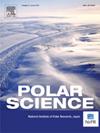利用遥感和现场仪器对南极高原东部(Dome-C)降水量进行统计研究
IF 1.5
4区 地球科学
Q3 ECOLOGY
引用次数: 0
摘要
研究极高纬度地区的降水是一项挑战,尤其是在极地冬季。直接监测高纬度降水中冰的习性和大小,对于验证雷达降水推导算法和改进极地地区气候学建模至关重要。高原缺乏对降水的长期直接观测。这项工作在协和站(Dome-C,南纬-75°,东经 123°,海拔 3233 米)进行,利用去极化激光雷达、平板扫描仪(ICECAMERA)、微波剖面仪(HAMSTRAD)和气象仪器,对 2014-2021 年期间降水的形状、大小、高度和形成温度进行了研究。降水源分为四种类型:冰雾、液雾、混合相云和卷云。为 Dome-C 选取了十种有代表性的冰层习性。计算了每种习性的大小分布,以便估算相应的雷达反射率。使用 W 波段雷达,例如灵敏度为 -28 分贝的 CLOUDSAT,可以捕捉到在协和星观测到的所有晶体。在云降水的典型冰习性中,粒度和高度之间呈正相关趋势。云层高度的西北风和东北风从沿海地区吹来,造成了大部分云降水。该研究还考察了降水冰习性组成的高度趋势。研究分析了四种降水来源的冰习性成分,并探讨了通过观测降水来确定降水来源的可能性。这项研究首次对南极高原东部的降水进行了全面调查。本文章由计算机程序翻译,如有差异,请以英文原文为准。
A statistical study of precipitation on the eastern antarctic plateau (Dome-C) using remote sensing and in-situ instrumentation
Studying precipitation at very high latitudes is a challenge, particularly during the polar winter. Direct monitoring of ice habit and size in high latitude precipitation is crucial for validating the algorithms used to derive precipitation from radar, and for improving the climatological modeling of polar areas. The high plateau lacks long-term direct observations of precipitation. In this work, carried out at Concordia Station (Dome-C (DC), −75°S, 123°E, 3233 m a.m.s.l), the use of a depolarization LIDAR, a flatbed scanner (ICECAMERA), a microwave profiler (HAMSTRAD) and meteorological instrumentation made possible the study, over the period 2014–2021, of shape, size, height and temperature of formation of precipitation. The precipitation sources were classified into four types: ice fogs, liquid fogs, mixed-phase clouds, and cirrus. Ten representative ice habits for Dome-C were chosen. The size distribution for every habit was calculated, allowing for the estimation of the corresponding radar reflectivity. The use of W-band radars, such as CLOUDSAT, with a sensitivity of −28dB, resulted in capturing all the crystals observed in Concordia. A positive trend was observed between grain size and height in ice habits that are typical of cloud precipitation. North West (NW) and North East (NE) winds at cloud height, blowing from coastal regions, caused the majority of precipitation from clouds. The study also examined the height trend of the ice habit composition of precipitation. The ice habit composition for each of the four types of precipitation source was analyzed, and the possibility of determining the source by simply observing the precipitation was explored. This work marks the first comprehensive investigation of precipitation on the eastern Antarctic plateau.
求助全文
通过发布文献求助,成功后即可免费获取论文全文。
去求助
来源期刊

Polar Science
ECOLOGY-GEOSCIENCES, MULTIDISCIPLINARY
CiteScore
3.90
自引率
5.60%
发文量
46
期刊介绍:
Polar Science is an international, peer-reviewed quarterly journal. It is dedicated to publishing original research articles for sciences relating to the polar regions of the Earth and other planets. Polar Science aims to cover 15 disciplines which are listed below; they cover most aspects of physical sciences, geosciences and life sciences, together with engineering and social sciences. Articles should attract the interest of broad polar science communities, and not be limited to the interests of those who work under specific research subjects. Polar Science also has an Open Archive whereby published articles are made freely available from ScienceDirect after an embargo period of 24 months from the date of publication.
- Space and upper atmosphere physics
- Atmospheric science/climatology
- Glaciology
- Oceanography/sea ice studies
- Geology/petrology
- Solid earth geophysics/seismology
- Marine Earth science
- Geomorphology/Cenozoic-Quaternary geology
- Meteoritics
- Terrestrial biology
- Marine biology
- Animal ecology
- Environment
- Polar Engineering
- Humanities and social sciences.
 求助内容:
求助内容: 应助结果提醒方式:
应助结果提醒方式:


